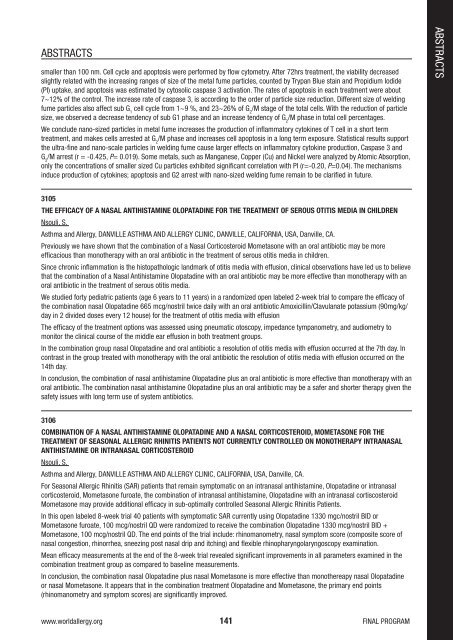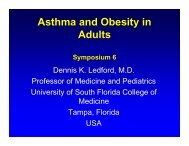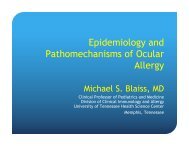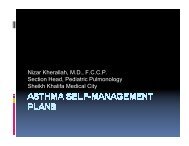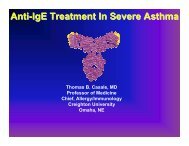Dubai Final-v20.indd - World Allergy Organization
Dubai Final-v20.indd - World Allergy Organization
Dubai Final-v20.indd - World Allergy Organization
Create successful ePaper yourself
Turn your PDF publications into a flip-book with our unique Google optimized e-Paper software.
ABstrACts<br />
smaller than 100 nm. Cell cycle and apoptosis were performed by flow cytometry. After 72hrs treatment, the viability decreased<br />
slightly related with the increasing ranges of size of the metal fume particles, counted by trypan Blue stain and Propidium iodide<br />
(Pi) uptake, and apoptosis was estimated by cytosolic caspase 3 activation. the rates of apoptosis in each treatment were about<br />
7~12% of the control. the increase rate of caspase 3, is according to the order of particle size reduction. Different size of welding<br />
fume particles also affect sub g cell cycle from 1~9 %, and 23~26% of g /m stage of the total cells. With the reduction of particle<br />
1 2<br />
size, we observed a decrease tendency of sub g1 phase and an increase tendency of g /m phase in total cell percentages.<br />
2<br />
We conclude nano-sized particles in metal fume increases the production of inflammatory cytokines of t cell in a short term<br />
treatment, and makes cells arrested at g /m phase and increases cell apoptosis in a long term exposure. statistical results support<br />
2<br />
the ultra-fine and nano-scale particles in welding fume cause larger effects on inflammatory cytokine production, Caspase 3 and<br />
g /m arrest (r = -0.425, P= 0.019). some metals, such as manganese, Copper (Cu) and nickel were analyzed by Atomic Absorption,<br />
2<br />
only the concentrations of smaller sized Cu particles exhibited significant correlation with Pi (r=-0.20, P=0.04). the mechanisms<br />
induce production of cytokines; apoptosis and g2 arrest with nano-sized welding fume remain to be clarified in future.<br />
3105<br />
THE EFFiCaCY oF a naSal anTiHiSTaminE oloPaTaDinE For THE TrEaTmEnT oF SEroUS oTiTiS mEDia in CHilDrEn<br />
nsouli, s.<br />
Asthma and <strong>Allergy</strong>, DAnVillE AstHmA AnD AllErgY CliniC, DAnVillE, CAliFOrniA, UsA, Danville, CA.<br />
Previously we have shown that the combination of a nasal Corticosteroid mometasone with an oral antibiotic may be more<br />
efficacious than monotherapy with an oral antibiotic in the treatment of serous otitis media in children.<br />
since chronic inflammation is the histopathologic landmark of otitis media with effusion, clinical observations have led us to believe<br />
that the combination of a nasal Antihistamine Olopatadine with an oral antibiotic may be more effective than monotherapy with an<br />
oral antibiotic in the treatment of serous otitis media.<br />
We studied forty pediatric patients (age 6 years to 11 years) in a randomized open labeled 2-week trial to compare the efficacy of<br />
the combination nasal Olopatadine 665 mcg/nostril twice daily with an oral antibiotic Amoxicillin/Clavulanate potassium (90mg/kg/<br />
day in 2 divided doses every 12 house) for the treatment of otitis media with effusion<br />
the efficacy of the treatment options was assessed using pneumatic otoscopy, impedance tympanometry, and audiometry to<br />
monitor the clinical course of the middle ear effusion in both treatment groups.<br />
in the combination group nasal Olopatadine and oral antibiotic a resolution of otitis media with effusion occurred at the 7th day. in<br />
contrast in the group treated with monotherapy with the oral antibiotic the resolution of otitis media with effusion occurred on the<br />
14th day.<br />
in conclusion, the combination of nasal antihistamine Olopatadine plus an oral antibiotic is more effective than monotherapy with an<br />
oral antibiotic. the combination nasal antihistamine Olopatadine plus an oral antibiotic may be a safer and shorter therapy given the<br />
safety issues with long term use of system antibiotics.<br />
3106<br />
ComBinaTion oF a naSal anTiHiSTaminE oloPaTaDinE anD a naSal CorTiCoSTEroiD, momETaSonE For THE<br />
TrEaTmEnT oF SEaSonal allErgiC rHiniTiS PaTiEnTS noT CUrrEnTlY ConTrollED on monoTHEraPY inTranaSal<br />
anTiHiSTaminE or inTranaSal CorTiCoSTEroiD<br />
nsouli, s.<br />
Asthma and <strong>Allergy</strong>, DAnVillE AstHmA AnD AllErgY CliniC, CAliFOrniA, UsA, Danville, CA.<br />
For seasonal Allergic rhinitis (sAr) patients that remain symptomatic on an intranasal antihistamine, Olopatadine or intranasal<br />
corticosteroid, mometasone furoate, the combination of intranasal antihistamine, Olopatadine with an intranasal cortiscosteroid<br />
mometasone may provide additional efficacy in sub-optimally controlled seasonal Allergic rhinitis Patients.<br />
in this open labeled 8-week trial 40 patients with symptomatic sAr currently using Olopatadine 1330 mgc/nostril BiD or<br />
mometasone furoate, 100 mcg/nostril QD were randomized to receive the combination Olopatadine 1330 mcg/nostril BiD +<br />
mometasone, 100 mcg/nostril QD. the end points of the trial include: rhinomanometry, nasal symptom score (composite score of<br />
nasal congestion, rhinorrhea, sneezing post nasal drip and itching) and flexible rhinopharyngolaryngoscopy examination.<br />
mean efficacy measurements at the end of the 8-week trial revealed significant improvements in all parameters examined in the<br />
combination treatment group as compared to baseline measurements.<br />
in conclusion, the combination nasal Olopatadine plus nasal mometasone is more effective than monothereapy nasal Olopatadine<br />
or nasal mometasone. it appears that in the combination treatment Olopatadine and mometasone, the primary end points<br />
(rhinomanometry and symptom scores) are significantly improved.<br />
www.worldallergy.org 141<br />
FinAl PrOgrAm<br />
ABstrACts


